Slide Set B: Welcome, Vision, and Meeting Objectives
This website is archived for historical purposes and is no longer being maintained or updated.
Download the complete slide set:
- 24 Slides in Adobe PDF Format - [3.7MB]
- 24 Slides in PowerPoint PPT Format - [1.6MB]
- 24 Slides in Adobe Flash Format - [45KB]

While the content is in the public domain and no copyright restriction applies, we do ask that users preserve the slides in their current format and cite CDC as the source.
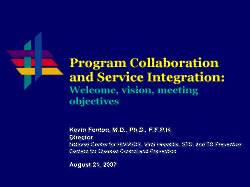
Slide 1
Program Collaboration and Service Integration
Welcome, vision, meeting objectives
PDF File or PPT File
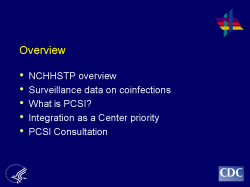
Slide 2
Overview
PDF File or PPT File

Slide 3
NCHHSTP Mission
PDF File or PPT File
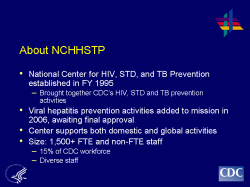
Slide 4
About NCHHSTP
PDF File or PPT File
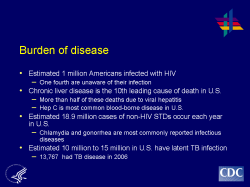
Slide 5
Burden of disease
PDF File or PPT File
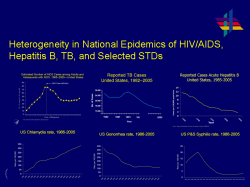
Slide 6
Heterogeneity in National Epidemics of HIV/AIDS, Hepatitis B, TB, and Selected STDs.
PDF File or PPT File
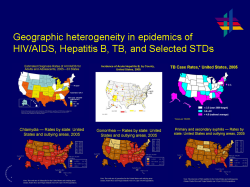
Slide 7
Geographic heterogeneity in epidemics of HIV/AIDS, Hepatitis B, TB, and Selected STDs
PDF File or PPT File

Slide 8
HIV/AIDS, Hepatitis, STD and TB Common determinants
PDF File or PPT File
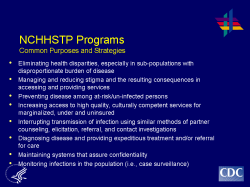
Slide 9
NCHHSTP Programs Common Purposes and Strategies
PDF File or PPT File

Slide 10
CDC Goals and Strategic Imperatives Shared Leadership Values
PDF File or PPT File
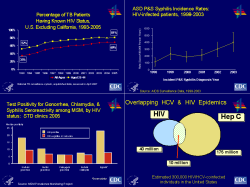
Slide 11
Overlapping Syndemics of HIV, STDs, TB, and Viral Hepatitis
PDF File or PPT File
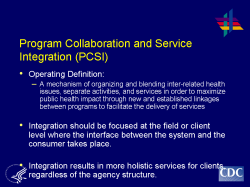
Slide 12
Program Collaboration and Service Integration (PCSI)
PDF File or PPT File
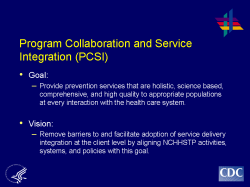
Slide 13
Program Collaboration and Service Integration (PCSI)
PDF File or PPT File

Slide 14
What Are the Potential Benefits of PCSI?
PDF File or PPT File
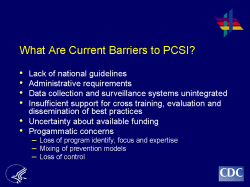
Slide 15
What Are Current Barriers to PCSI?
PDF File or PPT File
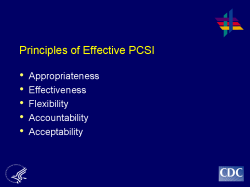
Slide 16
Principles of Effective PCSI
PDF File or PPT File
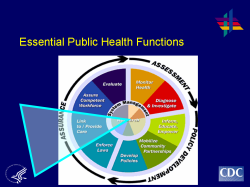
Slide 17
Essential Public Health Functions.
PDF File or PPT File

Slide 18
CDC Consultation on Program Collaboration and Service Integration
PDF File or PPT File
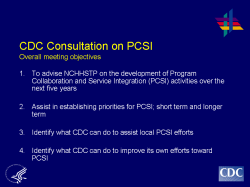
Slide 19
CDC Consultation on PCSI Overall meeting objectives
PDF File or PPT File
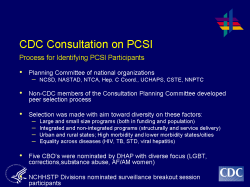
Slide 20
CDC Consultation on PCSI Process for Identifying PCSI Participants.
PDF File or PPT File
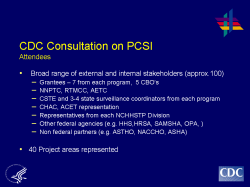
Slide 21
CDC Consultation on PCSI Attendees
PDF File or PPT File
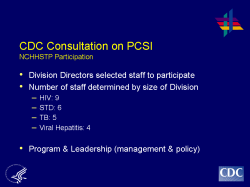
Slide 22
CDC Consultation on PCSI NCHHSTP Participation
PDF File or PPT File
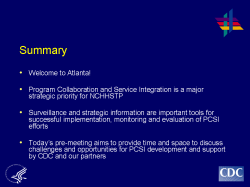
Slide 23
Summary
PDF File or PPT File
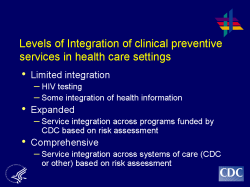
Slide 24
Levels of Integration of clinical preventive services in health care settings
PDF File or PPT File
- Page last reviewed: March 5, 2014 (archived document)
- Content source:


 ShareCompartir
ShareCompartir


